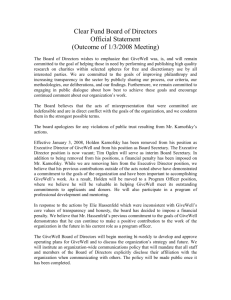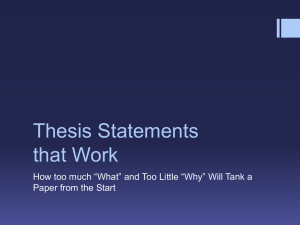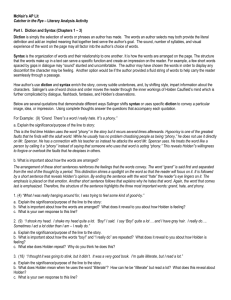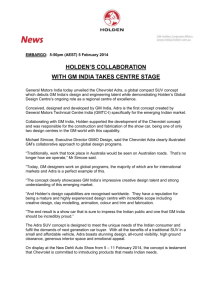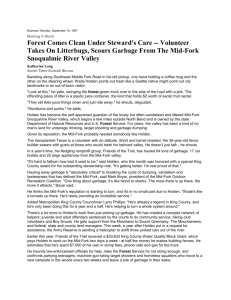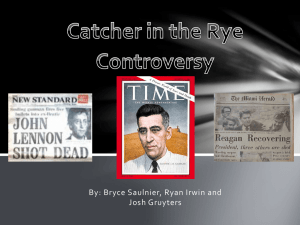Patient-engaged human factors
advertisement
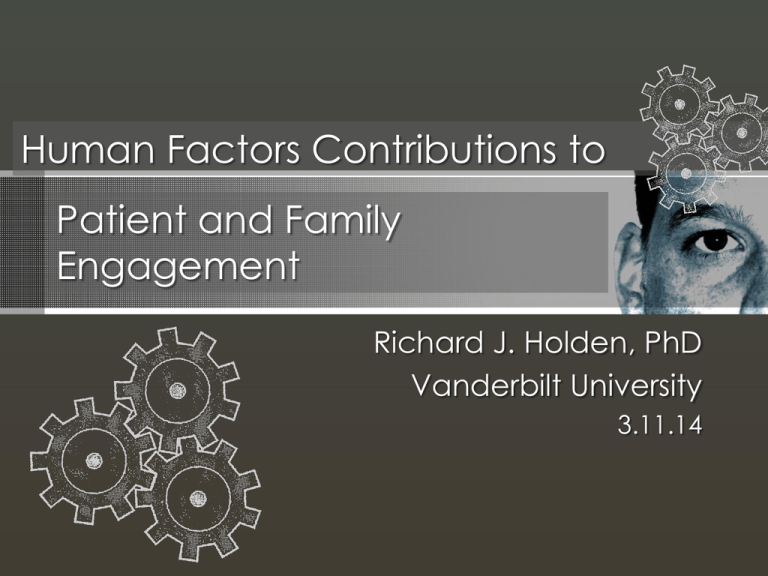
Human Factors Contributions to Patient and Family Engagement Richard J. Holden, PhD Vanderbilt University 3.11.14 Human factors contributions… 1. Human factors can contribute to healthcare what it has done for aviation, nuclear power, etc. 2. Human factors can contribute to primary care what it has done for aviation, nuclear power, etc. 3. Human factors can contribute to patients and families what it has done for professionals (pilots, MDs, RNs, etc.) 2 Human factors “The road to patient safety runs through the provider, so design work systems to support performance and hazard reduction: an alternative patient safety paradigm” 3 Human factors methods (Gawron, 2000; Stanton et al, 2013; Wickens et al, 2004; etc.) Source: Word cloud of tables of content for human factors methods books and chapters (edited) 4 Human factors - 5 Human factors 6 “SEIPS 2.0” [Systems Engineering Initiative for Patient Safety] Holden, R. J., Carayon, P., Gurses, A. P., Hoonakker, P., Hundt, A. S., Ozok, A. A., & Rivera-Rodriguez, A. J. (2013). SEIPS 2.0: A human factors framework for studying and improving the work of healthcare professionals and patients. Ergonomics, 56(11), 1669-1686. Patient-engaged human factors Patient-engaged human factors “The application of human factors theories and principles, methods and tools, analyses, and interventions to study and improve work done by patients and families, alone or in concert with healthcare professionals.” (Holden & Mickelson, 2013; Holden et al., 2013) 8 Patient-engaged human factors 9 Patient-engaged human factors • AMAcan Code of Medical Ethics engaged, • Patients (and should) be “empowered, equipped, enabled” • • • • • 1847 (original): The obedience of a patient to Patients and families are the most underused resource in the prescriptions of his physician should be healthcare prompt and implicit. He should never permit his own crude opinions . . . to influence his Healthcare is shifting away from the paternalistic model attention to them. (culturally & legally) • 2012-13 (current): Physician and patient are There are ongoing efforts to support patient engagement, bound in a partnership that requires both including throughto electronic tools role in the healing individuals take an active process Patients and family members already engage in decision making, information management, etc. 10 Patient-engaged human factors 11 Patient-engaged human factors • Not new, but much needed – – – – – – – – – – – – – Patient-clinician-technology trust, communication (Montague) Family-centered pediatric rounds (Carayon, Cox) Patient health information search (Marquard) Human factors of home care and IT (Zayas Cabán, Brennan, Valdez) User-centered IT design to support med adherence (Ozok, Siek) HF design of labels, charts, reminders for ill elderly (Morrow) Control theory applied to diabetes self-management (Altman Klein) Resilience engineering and medication taking (Furniss, Barber) Care pathways for chronically ill elderly (Waterson, Eason) Use, usability of personal health records (Czaja, Pak) Technology for aging in place (Rogers, Fisk, Mitzner) Instructional design and education for patients (McLaughlin) Etc. 12 (Five) contributions of human factors to patient and family engagement • • • • • • • • • • • • The systems model Work/task/process analysis Workload and situation awareness tools Teamwork-facilitating methods Incident capture and analysis Physical ergonomics, load stress evaluation, facilities dx Individual/team training, expert/novice differences Adaptive automation, augmented reality Human-computer interaction, user interface design User-centered design process, usability testing Simulation, VR, microworlds (& lots more!) 13 (Five) contributions of human factors to patient and family engagement • • • • • The systems model Work/task/process analysis Workload and situation awareness tools Teamwork-facilitating methods Incident capture and analysis 1) Outpatients with heart failure NIA/NIH K01AG044439, PI: Holden 2) Patients and family members describing nonroutine episodes of care PCORI IP2 PI000072-01, PI: Weinger 14 #1. The systems model Hazards/barriers to optimal self-care adherence? Vs. External Environment 15 #1. The systems model Barriers to self-care (from > 3100 references) Barrier # barrier subtypes % pts w/ barrier (N=30) Avg. # per patient Person (patient) 63 100% 40.3 Person (caregiver) 17 67% 5.5 Task 22 100% 10.4 Tool/technology 17 83% 5.8 Physical-spatial 13 83% 3.8 Socio-cultural 14 90% 4.9 Organizational 41 100% 17.0 Interaction 22 93% 7.7 Total = 209 (Holden & Mickelson, 2013) 16 2. Self-care performance is shaped by specific “work system” factors 17 An 85 year old woman with heart failure 1 Although she knows importance of exercise 2 and is motivated to exercise, 3 walking is difficult for the patient 4 due to physical impairment and fatigue. 3 5 7 Patient 1 9 2 4 10 However, she can swim 6 and has access to an outdoor community pool. 7 Although she has no car, 8 Son 8 6 12 5 her son drives her there in the summer. 9 When the weather gets cold, 11 10 this outdoor pool is closed. 11 She does have access to a local gym w/ pool. 12 However, she chooses not to go there # facilitating factor # impeding factor because the gym’s other patrons tend to be younger and she is self-conscious about what they will think when they see all her surgical scars. 18 #2. Work/task/process analysis What do patients and families do? How? When? Why? Where? With whom? What are key variances? 19 #2. Work/task/process analysis Wake up Go out for day Weigh self Check for swelling home Go to sleep Prepare meal Other vitals Write down Take meds Drink coffee Bathroom Extra diuretic Take meds Caregiver Sleep Wake #2. Work/task/process analysis 21 #2. Work/task/process analysis 22 #2. Work/task/process analysis Aarhus & Ballegaard, 2010 23 #3. Workload and situation awareness What are the demands on patients/families, relative to available resources? How aware are patients/families of what happened, what is happening, what might happen? Can we optimize workload and situation awareness? (May et al, 2009) 24 #3. Workload and situation awareness Demands • Work volume • Work complexity • Time required • Number of tasks • Inefficiency (Situational) • • • • • • Constraints Distractions Task switch cost Processing costs Task complexity, timing Task conflict Resources • Assistance from others • Time, energy • Skill/abilities • Technology • Simplifying routines • Familiarity/expertise Holden et al, 2010 25 #3. Workload and situation awareness Demands • Work volume • Work complexity • Time required • Number of tasks • Inefficiency (Situational) • • • • • • “I started coming out here, taking my blood pressure, taking my weight, and sugar count, so forth 'til I feel like a secretary… it Resources aggravates the fool out of me. I • Assistance from others get up in the mornings, it takes me 30 minutes•toTime, put myenergy clothes on, get all my scales, and get into the • Skill/abilities kitchen at my little table back • Technology there I've got, and take all this • Simplifying routines stuff, pressures, blood pressures, uh, sugar count, and I, I ought to • Familiarity/expertise get me a degree, you know, I, I'm almost a doctor.” Constraints Distractions Task switch cost Processing costs Task complexity, timing Task conflict 26 #3. Workload and situation awareness Situation awareness “The perception of elements in the environment within a volume of time and space, the comprehension of their meaning, and the projection of their status in the near future“ (Endsley, 1995) or “What? So what? Now what?” (Tenney & Pew, 2006) 27 #3. Workload and situation awareness What do we do when I cannot breathe anymore?? “I was in the ER (emergency room) one time with a horrible case of strep throat, and my throat was literally closing up. And the nurse just came in and she gave me an IV, and some pills, and said, “I'll come back and check on you,” right? And I got to the point where if I leaned back, I couldn't breathe at all. I had to sit up to breathe. So, I literally, I mean, I was in there probably an hour just sitting by myself, and I had a pad, and I wrote out, “What do we do when I cannot breathe anymore?” #4. Teamwork-facilitating methods Are patients and families truly part of a “team” with professionals? How can patient/family-professional collaboration be measured, improved? 29 #4. Teamwork-facilitating methods Characteristics of successful teams (Salas et al., 2000, 2008) Characteristic Are we there yet? Can HFE help? Interdependence Common goals Shared situation awareness Common ground (e.g., shared lingo, ideas) Strong coordinating mechanisms Leadership-subordination Reliable communication systems Specific, timely, reliable feedback Adaptable, flexible Strong interpersonal relations Deference to expertise during decisions … 30 #4. Teamwork-facilitating methods Nurse: Using your Spiriva inhaler? MD: So mom says she needs... Patient: Yeah....that's blue, ain’t it? Patient: Maximillistine, I can’t say it, you know. Nurse: I don't know. MD: Well, it’s Maxaltine, but you’re not on that. Patient: Yeah, only though, not like the blue one all the time. What you call it? Nurse: I don't know. I don't, I don't know what those look like. Patient: I can’t say it....I have to take it twice a day, it’s supposed to be three times, I take it twice a day. It’s orange and kind of brown. 31 #5. Incident capture and analysis What kind of nonroutine events do patients and families report? Intervention (Rescue or Recovery) RISK Deviation from Optimal Care O PTI MAL CAR E PATH Non-Routine Event (NRE) Adverse Outcome “Optimal” Outcome Performance Shaping Factors 32 Good news/bad news about human factors contributions to patient engagement • “The extent to which human factors research is incorporated into home-based devices, technologies, and practices will have a big influence on whether greater reliance on home health care proves to have beneficial or detrimental effects on people’s lives.” (National Research Council, 2011) • “There are many resources available from other disciplines to help healthcare move to where it needs to be in terms of patient engagement … There are some great minds working in this space, including behavioral economists, user experience designers, community leaders, interaction designers, software developers and game designers, risk managers, data scientists, and actuaries.” (Kish, 2012) 33 Thank you! Questions? Rich Holden, PhD, richard.holden@vanderbilt.edu Our R&D Team Chris Schubert, PhD Courtney Thomas, MA Robin Mickelson, MS, RN Amanda McDougald Scott, MS Tony Threatt, PhD Russ Beebe, MA Human work performance (1) Occurs in context & (2) Is adaptive Karl Ulrich (K.U.) Smith Michael J. Smith “We begin our adventure into the science of psychology not in the laboratory but at home, at school, at work, in all of the familiar life situations. … Human behavior involves a continuing series of adjustments … We can learn much by examining these adjustments as they occur in their natural settings.” Ben-Tzion Karsh me K.U. Smith & W.M. Smith, 1958

